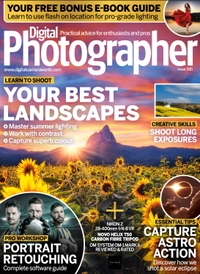"In the literary genre of ‘magic realism’, authors blend realistic narratives with surreal or fantastical elements - I use a similar technique in my photography"
Michael Bross discusses four vital photographic decisions for capturing scenes that blend fuse dream-like ambiance with realism

Michael Bross is a master in the art of capturing natural and urban landscapes. He says, "I wander the world with my camera, seeking to capture solitude, serenity and beauty and to connect with others through my photography.”
I had the pleasure of interviewing him about his work and analyzing his image 'Cloud over houses'. We discussed the techniques he used to capture the photo and why it works...
1. Moody tones
Color grading is a popular technique that’s used in post-processing to create atmospheric hues that underline the atmosphere of the shot. “I typically aim for a palette that maximises the emotional impact and resonates with the essence of the capture,” Michael says. “The houses, in safe, calming hues, contrast with the unsettling blue tone of the cloud, evoking a sense of unease,” he adds. “I do all my editing and processing in Lightroom and here, I used colour grading while
also bumping up the luminance of the blue hue.”
2. Magic realism
“In the literary genre of ‘magic realism’, authors blend realistic narratives with surreal or fantastical elements. I use a similar technique in photography, subtly infusing dream-like ambience with realism,” explains Michael. “In this tranquil scene of homes, the looming cloud raises questions: Does it herald a foreboding storm or will it silently drift away? I wanted to evoke a sense of the orderly against the unpredictable.”
3. Repetitive elements
“I love how Wes Anderson shoots his films using symmetry and so there’s some of that influence in this capture,” says Michael. The symmetry is highlighted, allowing the viewer to experience a balanced frame and to automatically compare elements within the composition, while their view is guided through the foreground and up to the background. “The recurring elements of the houses primarily reinforce the orderly atmosphere captured in the photo,” he adds. “Again, it’s echoing a touch of Wes Anderson’s influence.”
4. Dab of color
The houses are neatly lined up, providing symmetry to the image composition, but one window stands out as an element of interest. Located in the center-left of the foreground, the color in this window distinguishes it from other elements in the image. “The window reflected the lingering orange glow of the post-sunset clouds. I toned down the reflection in Lightroom to maintain the compositional balance,” he says.
Tech details

Camera: Canon 5D Mark IV
Get the Digital Camera World Newsletter
The best camera deals, reviews, product advice, and unmissable photography news, direct to your inbox!
Lens: Canon EF 70-300mm f/4-5.6L IS USM
Aperture: f/5
Shutter speed: 1/160 sec
ISO: 1250
Focal length: 170mm

Originating from a remote Pennsylvania forest town, Michael Bross has called California home for the past 23 years. As a photographer, his main pursuit is natural and urban landscapes. Previously a composer of soundtracks for popular video games, he now leads a design team in the field of augmented reality.
Others in the Why Shots Work series
- Urban street photographer reveals his candid capture secrets
- Photographer tells story of getting up close and personal with a python
- Discover four key elements that make this stunning photo a success
- The 4 photographic decisions that take this motorsport shot to the next level
- Photographer tells story of his amazing shot of wallabies fighting on the beach
This article originally appeared in Digital Photographer, a monthly magazine, and the kitbag essential for pros, enthusiasts, and amateurs alike!
Inside, you'll find practical guides, shooting tips, and techniques from working photographers, plus all the latest industry news.

Kim is the Staff Writer on Digital Camera World, and formerly Technique Editor at Digital Photographer, focusing on the art and science of photography. With a Master’s degree in Photography and Media, she is driven to educate through an analytical approach, visually and technically. With her guides and tutorials, Kim seeks to uncover new facets of this time-honoured medium and foster a deeper understanding of its profound role in culture. Kim highlights topics that resonate with modern society, including women in photography and critical issues such as environmental conservation. She also discusses and reviews camera gear, giving you an overview to find the best fit for your photography journey.

